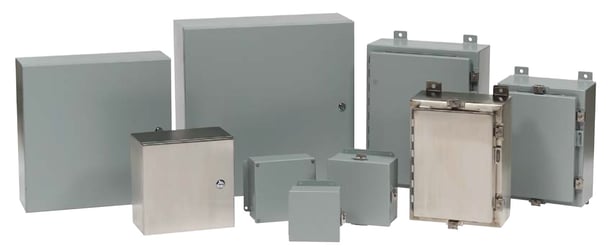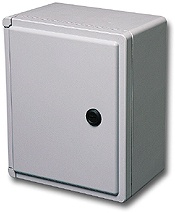Electrical enclosures, also known as junction enclosures, are often chosen for their multi-purpose use for indoor and outdoor applications.

There are a variety of electrical enclosures, available on the market, ranging in many sizes and configurations. When researching the various options, it can quickly become overwhelming. However, enclosing electrical and electronic controls, instrumentation, components, and associated wiring does not need to be challenging. There are a few items that should be evaluated before making a concrete decision.
5 Enclosure Considerations to Help Simplify Process
Enclosure Material
Ranging from fiberglass to carbon steel to stainless steel, each material will serve a different purpose, depending on the type of environment. Fiberglass or stainless steel electrical enclosures are best suited for areas exposed to harsh chemicals. Stainless steel is an impeccable material if the enclosure will need to be cleaned on a daily basis with abrasive, hose directed fluids. Thekitchn.com describes stainless steel quite perfectly, “Stainless steel is a metal alloy with about 10-11% chromium. When exposed to air, the chromium in the metal forms a film of chromium oxide over the surface. This film is passive and non-toxic, and most importantly, it prevents the steel from rusting by shielding it from air and moisture. Even if the metal gets scratched, the chromium oxide reforms seamlessly.” Milder environments, such as factory floors or outdoor environments, are generally well suited for a carbon steel enclosure with a protective powder coat paint finish.
NEMA Rating
Junction enclosures are available in a variety of NEMA (National Electrical Manufacturers Association) ratings. According to Electronics Protection Magazine, “the term ‘NEMA ratings’ is used colloquially to refer to a very specific standard for electrical enclosures.  NEMA standard ICS 6 categorizes enclosure types according to their ability to protect against ingress or damage due to liquids, dust and corrosive chemicals.” When choosing the best enclosure for the job, determine the recommended NEMA rating for the installation environment.
NEMA standard ICS 6 categorizes enclosure types according to their ability to protect against ingress or damage due to liquids, dust and corrosive chemicals.” When choosing the best enclosure for the job, determine the recommended NEMA rating for the installation environment.
- NEMA 12 enclosures protect against falling dirt, circulating dust and light splashing fluids.
- NEMA 4 enclosures protect against falling dirt, windblown dust, splashing water and hose directed water.
- NEMA 4X enclosures protect against falling dirt, windblown dust, splashing water, hose directed water and detrimental corrosion.
Level of Security
When specifying an electrical enclosure, not all latches are created equal. Enclosures are available with a number of latching mechanisms that range from key locking, screw cover, padlock, link lock, or twist turn latches. Determine if employees will need access to components inside of the enclosure on a regular basis, or if access should be restricted to only a few ‘upper echelon’ managers or individuals. Various hinges can also be selected depending on the type of latch that is ultimately chosen. Subject to the contents of the enclosure, a simple latch may not be sufficient in protecting the electronics or other peripherals.
Sub Panel / Back Plate
Sub Panels, or back mounting plates, are a popular feature for electrical enclosures. A thin plate, generally constructed out of aluminum, is installed in the back of the enclosure for mounting controls, instrumentation and various other pertinent components.
Accessories
Junction enclosures, generally speaking, are one of the most basic kind of environmental enclosures. Be sure to consider additional accessories that will help customize the enclosure to be the most useful product for your specific needs. Considerations such as window kits will allow visibility of the controls from the outside. Other accessories that may be useful include: mounting feet, front panels, cord grips, carrying handles, print pockets, drain & vents, louver plate vents, conduit hubs, and fiberglass hole plugs. In addition, thermal management is always an important consideration when installing electronics in a sealed enclosure. A simple circulating fan can extend the life of electronics for many years.
Finding the right enclosure to protect vital electronics and devices should be a carefully planned procedure. A junction enclosure offers many levels of protection and cannot be chosen without meticulously considering relevant items. If an enclosure fails because it was placed in a damaging environment, then whatever is inside of the enclosure will potentially fail too! Never underestimate the power of proper planning. Always remember that choosing the wrong enclosure will cost more money in the long run, so always select the finest quality enclosure to protect your investment and maximize the life of your electronics.
For more information, Visit: 6 CONSIDERATIONS FOR SPECIFYING COMPUTER ENCLOSURES
HAVE QUESTIONS? LET US KNOW HOW WE CAN BEST ASSIST YOU! CONTACT AN 'ITSENCLOSURES EXPERT' AT 1-800-423-9911 -OR- SEND US AN EMAIL: INFO@ITSENCLOSURES.COM



